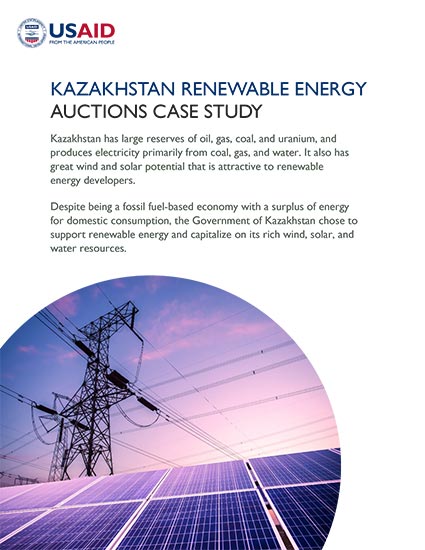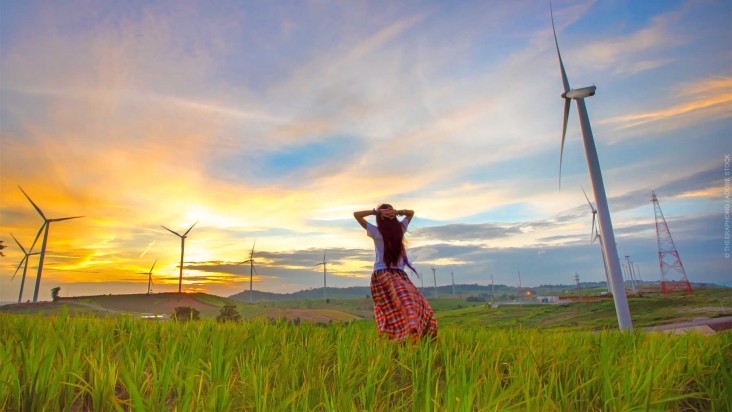-
Makpal Abduldinova / USAID
Energy Auctions for Kazakhstan’s Green Economy
Despite being a fossil fuel-based economy with a surplus of energy, Kazakhstan has a successful renewable energy auction program that is transforming its energy sector and diversifying its energy mix. Visit the website
Kazakhstan’s auctions resulted in over 1 GW of new renewable energy projects awarded using a competitive, transparent framework in a primarily coal-based power system.
Kazakhstan has large reserves of oil, gas, coal, and uranium and produces electricity primarily from coal, gas, and water. It also has great wind and solar potential that is attractive to renewable energy developers. Despite the country’s fossil fuel–based economy with its surplus of energy for domestic consumption, the Government of Kazakhstan chose to support renewable energy and capitalize on its rich wind, solar, and water resources.
Laying a Foundation for a Green Economy
Over the last several years, auctions emerged as a best practice to facilitate competitive renewable energy price setting, lower costs, expand access to affordable and sustainable energy, and increase transparency of energy procurement. In 2017, the Government of Kazakhstan replaced feed-in tariff (FiT) procurements with renewable energy auctions to accelerate progress toward meeting its renewable energy targets and capitalize on falling renewable energy prices.
Key Features of Innovation and Success
In February 2018, the Ministry of Energy announced the first auctions by releasing the auction schedule, capacity limits, assigned land plots, grid connection points, types of renewable energy technology, auction ceiling prices, and other parameters. The price ceilings were set at the level of the feed-in tariffs that had been adopted by government resolution in 2014. The Government of Kazakhstan planned 20 auctions divided by land plots: 11 for small renewable energy projects and 9 for large ones. Due to the FiT program, there was a healthy pipeline of renewable projects that were in development and could compete in an upcoming auction.
Following are key features that helped test the market, limit exposure, increase competition, and reduce prices:
- Careful setting of capacity caps;
- Location and grid integration;
- Reduced concessions to investors;
- Dealing with foreign exchange indexation; and
- Attracting non-traditional developers.
Auction Results
With USAID assistance, the Government of Kazakhstan added over 1,000 MW of renewable energy projects in Kazakhstan through competitive auctions, with bid prices coming in between 23 and 64 percent below previous renewable tariff ceilings. Altogether, Kazakhstan saw a total of 28 auctions in 2018 and 2019.
Conclusion
Kazakhstan was the first Central Asian country to use auctions to contract renewable energy projects. In 2019, Uzbekistan followed suit and announced it would pursue auctions.
Kazakhstan’s successful 2018–2019 auction results show the effectiveness of moving from feed-in tariffs to auctions using a transparent and inclusive process and systematic tailoring to local context. The auctions made it possible to create competitive conditions, attract international investors, and significantly reduce renewable energy prices. At the same time, Kazakhstan’s experience illustrates the critical importance of working on grid integration and location issues while pursuing a successful auction program.
Happy woman relaxing with wind generators turbines beautiful sunset background in Khao Kho mountain, Petchabun, Thailand.
© theeraphong / Adobe Stock
Renewable energy auctions have emerged as the best practice for procuring least-cost energy. This competitive, transparent process helps countries meet their energy goals and attract private investment on their journey to self-reliance.
In today’s rapidly evolving renewable energy marketplace, it can be challenging to keep track of current best practices in renewable energy policy, innovations, and market trends. USAID developed the Renewable Energy Auction Toolkit to help international development professionals, energy ministries, utilities, policymakers, and regulators to design and successfully implement energy auctions that expand access to affordable and sustainable clean energy.
The proliferation of renewable energy resources requires comprehensive changes to power infrastructure, market design and business models. USAID, through its Scaling Up Renewable Energy (SURE) project, helps partner countries plan, procure, and integrate renewable energy. USAID’s efforts enhance global energy security; promote private sector investment through transparent, competitive procurement; and open paths to self-reliance by empowering partner countries to control their own economic and social development.



Comment
Make a general inquiry or suggest an improvement.